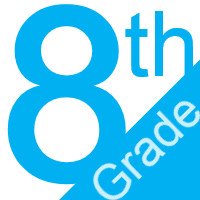8th Grade English
 Standards Glossaries
Standards Glossaries
| K Grade English | 1st Grade English | 2nd Grade English |
 Standards Glossaries
Standards Glossaries
| 3rd Grade English | 4th Grade English | 5th Grade English |
 Standards Glossaries
Standards Glossaries
| 6th Grade English | 7th Grade English | 8th Grade English |
 Standards Glossaries
Standards Glossaries
| 9th Grade English | 10th Grade English | 11th Grade English | 12th Grade English |
 Standards Glossaries
Standards Glossaries
| HS Journalism | HS Speech |
| (RI) Reading Information |
ELA-08.RI.01
Student Learning Targets for 8th Grade ELA:Knowledge Targets
Reasoning Targets
Skills (Performance) Targets
| ||||||||||||||||||||||||||||||||||||||||
| Score | RI.8.1 Cite the textual evidence that most strongly supports an analysis of what the text says explicitly as well as inferences drawn from the text. | Sample Activity |
|
| 4.0 | In addition to Score 3.0, the student demonstrates in-depth inferences and applications regarding more complex material that go beyond end of instruction expectations. | - | |
| 3.5 | In addition to Score 3.0 performance, the student demonstrates in-depth inferences and applications regarding the more complex content with partial success. | ||
| 3.0 |
“The Standard.” The student demonstrates no major errors or omissions regarding any of the information and processes that were end of instruction expectations. The student:
|
- | |
| 2.5 | The student demonstrates no major errors or omissions regarding the simpler details and processes (Score 2.0 content) and partial knowledge of the more complex ideas and processes (Score 3.0 content). | ||
| 2.0 |
The student demonstrates no major errors or omissions regarding the simpler details and processes but exhibits major errors or omissions regarding the more complex ideas and processes (Score 3.0 content). The student:
|
- | |
| 1.5 | The student demonstrates partial knowledge of the simpler details and processes (Score 2.0 content) but exhibits major errors or omissions regarding the more complex ideas and procedures (Score 3.0 content). | ||
| 1.0 | With help, the student demonstrates a partial understanding of some of the simpler details and processes (Score 2.0 content) and some of the more complex ideas and processes (Score 3.0 content). | - | |
| 0.5 | With help, the student demonstrates a partial understanding of some of the simpler details and processes (Score 2.0 content) but not the more complex ideas and processes (Score 3.0 content). | ||
To view the middle school Read Right Rubric click here.
Resources
Websites
Vocabulary
ELA-08.RI.01.a
ELA-08.RI.01 Read closely to comprehend Informational/Nonfiction text.
Proficiency ScaleThe student can ...1 Beginning... with help, demonstrates a partial understanding of some of the simpler details and processes (Score 2.0 content) and some of the more complex ideas and processes (Score 3.0 content).Start 2 Developing... demonstrates no major errors or omissions regarding the simpler details and processes but exhibits major errors or omissions regarding the more complex ideas and processes (Score 3.0 content).Simple 3 Proficient“The Standard.”... demonstrates no major errors or omissions regarding any of the information and processes that were end of instruction expectations. Target 4 Advanced... demonstrates in-depth inferences and applications regarding more complex material that go beyond end of instruction expectations.Complex | |
ELA-08.RI.01.b
ELA-08.RI.01 Read closely to comprehend Informational/Nonfiction text.
Proficiency ScaleThe student can ...1 Beginning... with help, demonstrates a partial understanding of some of the simpler details and processes (Score 2.0 content) and some of the more complex ideas and processes (Score 3.0 content).Start 2 Developing... demonstrates no major errors or omissions regarding the simpler details and processes but exhibits major errors or omissions regarding the more complex ideas and processes (Score 3.0 content).Simple 3 Proficient“The Standard.”... demonstrates no major errors or omissions regarding any of the information and processes that were end of instruction expectations. Target 4 Advanced... demonstrates in-depth inferences and applications regarding more complex material that go beyond end of instruction expectations.Complex | |
ELA-08.RI.01.c
ELA-08.RI.01 Read closely to comprehend Informational/Nonfiction text.
Proficiency ScaleThe student can ...1 Beginning... with help, demonstrates a partial understanding of some of the simpler details and processes (Score 2.0 content) and some of the more complex ideas and processes (Score 3.0 content).Start 2 Developing... demonstrates no major errors or omissions regarding the simpler details and processes but exhibits major errors or omissions regarding the more complex ideas and processes (Score 3.0 content).Simple 3 Proficient“The Standard.”... demonstrates no major errors or omissions regarding any of the information and processes that were end of instruction expectations. Target 4 Advanced... demonstrates in-depth inferences and applications regarding more complex material that go beyond end of instruction expectations.Complex | |
ELA-08.RI.02
Student Learning Targets for Grade 8 ELA:Knowledge Targets
Reasoning Targets
Skills (Performance) Targets
| ||||||||||||||||||||||||||||||||||||||||
| Score | R.I.8.2. Determine a central idea of a text and analyze its development over the course of the text, including its relationship to supporting ideas; provide an objective summary of the text. | Sample Activity |
|
| 4.0 | In addition to Score 3.0, the student demonstrates in-depth inferences and applications regarding more complex material that go beyond end of instruction expectations. | - | |
| 3.5 | In addition to Score 3.0 performance, the student demonstrates in-depth inferences and applications regarding the more complex content with partial success. | ||
| 3.0 |
“The Standard.” The student demonstrates no major errors or omissions regarding any of the information and processes that were end of instruction expectations. The student can
|
- | |
| 2.5 | The student demonstrates no major errors or omissions regarding the simpler details and processes (Score 2.0 content) and partial knowledge of the more complex ideas and processes (Score 3.0 content). | ||
| 2.0 |
The student demonstrates no major errors or omissions regarding the simpler details and processes but exhibits major errors or omissions regarding the more complex ideas and processes (Score 3.0 content). The student can
|
- | |
| 1.5 | The student demonstrates partial knowledge of the simpler details and processes (Score 2.0 content) but exhibits major errors or omissions regarding the more complex ideas and procedures (Score 3.0 content). | ||
| 1.0 | With help, the student demonstrates a partial understanding of some of the simpler details and processes (Score 2.0 content) and some of the more complex ideas and processes (Score 3.0 content). | - | |
| 0.5 | With help, the student demonstrates a partial understanding of some of the simpler details and processes (Score 2.0 content) but not the more complex ideas and processes (Score 3.0 content). | ||
Resources
Websites
Vocabulary
ELA-08.RI.03
Student Learning Targets:Knowledge Targets
Reasoning Targets
Skills (Performance) Targets
| ||||||||||||||||||||||||||||||||||||||||||||
| Score | Description | Sample Activity |
|
| 4.0 | In addition to Score 3.0, the student demonstrates in-depth inferences and applications regarding more complex material that go beyond end of instruction expectations. | - | |
| 3.5 | In addition to Score 3.0 performance, the student demonstrates in-depth inferences and applications regarding the more complex content with partial success. | ||
| 3.0 | “The Standard.” The student demonstrates no major errors or omissions regarding any of the information and processes that were end of instruction expectations. | - | |
| 2.5 | The student demonstrates no major errors or omissions regarding the simpler details and processes (Score 2.0 content) and partial knowledge of the more complex ideas and processes (Score 3.0 content). | ||
| 2.0 | The student demonstrates no major errors or omissions regarding the simpler details and processes but exhibits major errors or omissions regarding the more complex ideas and processes (Score 3.0 content). | - | |
| 1.5 | The student demonstrates partial knowledge of the simpler details and processes (Score 2.0 content) but exhibits major errors or omissions regarding the more complex ideas and procedures (Score 3.0 content). | ||
| 1.0 | With help, the student demonstrates a partial understanding of some of the simpler details and processes (Score 2.0 content) and some of the more complex ideas and processes (Score 3.0 content). | - | |
| 0.5 | With help, the student demonstrates a partial understanding of some of the simpler details and processes (Score 2.0 content) but not the more complex ideas and processes (Score 3.0 content). | ||
| 0.0 | Even with help, the student demonstrates no understanding or skill. | - | |
Resources
Websites
Vocabulary
ELA-08.RI.04
Student Learning Targets:Knowledge Targets
Reasoning Targets
Skills (Performance) Targets
Product Targets
Proficiency Scale
ResourcesWebsites Vocabulary | ||||||||||||||||||||||||||||||||||||||||||||
ELA-08.RI.05
Student Learning Targets:Knowledge Targets
Reasoning Targets
Skills (Performance) Targets
| ||||||||||||||||||||||||||||||||||||||||||||
| Score | Description | Sample Activity |
|
| 4.0 | In addition to Score 3.0, the student demonstrates in-depth inferences and applications regarding more complex material that go beyond end of instruction expectations. | - | |
| 3.5 | In addition to Score 3.0 performance, the student demonstrates in-depth inferences and applications regarding the more complex content with partial success. | ||
| 3.0 | “The Standard.” The student demonstrates no major errors or omissions regarding any of the information and processes that were end of instruction expectations. | - | |
| 2.5 | The student demonstrates no major errors or omissions regarding the simpler details and processes (Score 2.0 content) and partial knowledge of the more complex ideas and processes (Score 3.0 content). | ||
| 2.0 | The student demonstrates no major errors or omissions regarding the simpler details and processes but exhibits major errors or omissions regarding the more complex ideas and processes (Score 3.0 content). | - | |
| 1.5 | The student demonstrates partial knowledge of the simpler details and processes (Score 2.0 content) but exhibits major errors or omissions regarding the more complex ideas and procedures (Score 3.0 content). | ||
| 1.0 | With help, the student demonstrates a partial understanding of some of the simpler details and processes (Score 2.0 content) and some of the more complex ideas and processes (Score 3.0 content). | - | |
| 0.5 | With help, the student demonstrates a partial understanding of some of the simpler details and processes (Score 2.0 content) but not the more complex ideas and processes (Score 3.0 content). | ||
| 0.0 | Even with help, the student demonstrates no understanding or skill. | - | |
Resources
Websites
Vocabulary
ELA-08.RI.06
Student Learning Targets for 8th Grade ELA:Knowledge Targets
Reasoning Targets
Proficiency Scale
ResourcesWebsites Vocabulary | ||||||||||||||||||||||||||||||||||||||||
ELA-08.RI.07
Student Learning Targets:Knowledge Targets
Reasoning Targets
Skills (Performance) Targets
| ||||||||||||||||||||||||||||||||||||||||||||
| Score | Description | Sample Activity |
|
| 4.0 | In addition to Score 3.0, the student demonstrates in-depth inferences and applications regarding more complex material that go beyond end of instruction expectations. | - | |
| 3.5 | In addition to Score 3.0 performance, the student demonstrates in-depth inferences and applications regarding the more complex content with partial success. | ||
| 3.0 | “The Standard.” The student demonstrates no major errors or omissions regarding any of the information and processes that were end of instruction expectations. | - | |
| 2.5 | The student demonstrates no major errors or omissions regarding the simpler details and processes (Score 2.0 content) and partial knowledge of the more complex ideas and processes (Score 3.0 content). | ||
| 2.0 | The student demonstrates no major errors or omissions regarding the simpler details and processes but exhibits major errors or omissions regarding the more complex ideas and processes (Score 3.0 content). | - | |
| 1.5 | The student demonstrates partial knowledge of the simpler details and processes (Score 2.0 content) but exhibits major errors or omissions regarding the more complex ideas and procedures (Score 3.0 content). | ||
| 1.0 | With help, the student demonstrates a partial understanding of some of the simpler details and processes (Score 2.0 content) and some of the more complex ideas and processes (Score 3.0 content). | - | |
| 0.5 | With help, the student demonstrates a partial understanding of some of the simpler details and processes (Score 2.0 content) but not the more complex ideas and processes (Score 3.0 content). | ||
| 0.0 | Even with help, the student demonstrates no understanding or skill. | - | |
Resources
Websites
Vocabulary
ELA-08.RI.08
Student Learning Targets:Knowledge Targets
Reasoning Targets
Skills (Performance) Targets
| ||||||||||||||||||||||||||||||||||||||||
| Score | Description | Sample Activity |
|
| 4.0 | In addition to Score 3.0, the student demonstrates in-depth inferences and applications regarding more complex material that go beyond end of instruction expectations. | - | |
| 3.5 | In addition to Score 3.0 performance, the student demonstrates in-depth inferences and applications regarding the more complex content with partial success. | ||
| 3.0 | “The Standard.” The student demonstrates no major errors or omissions regarding any of the information and processes that were end of instruction expectations. | - | |
| 2.5 | The student demonstrates no major errors or omissions regarding the simpler details and processes (Score 2.0 content) and partial knowledge of the more complex ideas and processes (Score 3.0 content). | ||
| 2.0 | The student demonstrates no major errors or omissions regarding the simpler details and processes but exhibits major errors or omissions regarding the more complex ideas and processes (Score 3.0 content). | - | |
| 1.5 | The student demonstrates partial knowledge of the simpler details and processes (Score 2.0 content) but exhibits major errors or omissions regarding the more complex ideas and procedures (Score 3.0 content). | ||
| 1.0 | With help, the student demonstrates a partial understanding of some of the simpler details and processes (Score 2.0 content) and some of the more complex ideas and processes (Score 3.0 content). | - | |
| 0.5 | With help, the student demonstrates a partial understanding of some of the simpler details and processes (Score 2.0 content) but not the more complex ideas and processes (Score 3.0 content). | ||
To view the middle school Read Right Rubric click here.
Resources
Websites
Vocabulary



 Strand (RI)
Strand (RI)